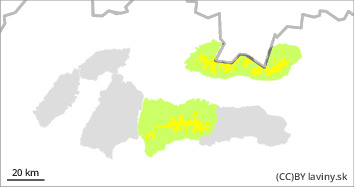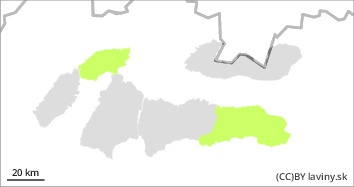
Danger level
 | 1800m |
|  |
|  |

Watch out for wind-blown boards on the leeward sides of the highest positions. Locally, there is a larger amount of new snow in the gullies.
In the Low and High Tatras there is a moderate avalanche danger above 1800 m above sea level. The main avalanche problem is wind-blown snow. Especially SE, E and NE orientations are dangerous. On the leeward sides of ridges in narrow couloirs and under rock walls there may be locally hard wind-beaten slabs, which are deposited on hard ground. Their loosening is possible with high additional loads on steep slopes. Small and medium-sized slab avalanches are particularly dangerous in combination with terrain traps. Spontaneous avalanches are not foreseen.
Snowpack
The surface of the snow cover is hard to icy in many places. During the last period of snowfall, the most new, mostly powdery snow fell in the Low and High Tatras. In places up to 15 cm. However, due to strong winds, it is very unevenly distributed. The windward sides of the mountains are hard and icy, on the leeward sides of the highest altitudes (SE, SW, SE and NE) there are slabs of wind-blown snow. Where snow has fallen without wind action there is loose powder snow. Most snow is found in northeast to east orientations. Continuous snow cover is found above 1600 m above sea level.
Tendency
Zotrvalá.



